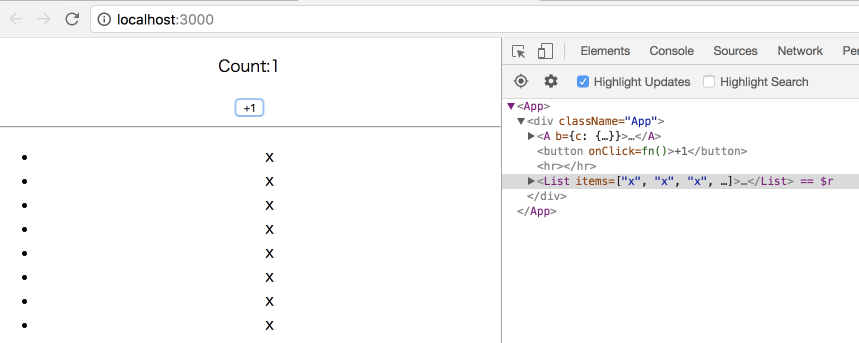shallow-equal for Object/React props
オブジェクトとReactのProps向けのShallow(浅い) equalライブラリを書きました。 Shallow Equalは対象のオブジェクトのプロパティをそれぞれ1段だけ比較することを言います。 ものすごく単純に書くならば次のようなことをするライブラリです。
const object = {}, targetObject = {};
const isEqualed = !Object.keys(object).some(key => {
return object[key] !== targetObject[key];
});
どちらもTypeScriptに対応していて、シンプルにオブジェクト同士を比較してbooleanを返すだけのライブラリです。
const { shallowEqual } = require("shallow-equal-object");
shallowEqual({ a: 1, b: 2 }, { a: 1, b: 2 }); // => true
shallowEqual({ a: 1, b: 2 }, { a: 1, b: 42 }); // => false
shallowEqual({ a: 1, b: 2 }, { }); // => false
shallow-equal-objectは、値の比較関数をカスタマイズできます。
デフォルトの比較関数はObject.isメソッド相当の実装がつかわれています。
これは、ReactのPureComponentやECMAScriptのProposalとして提出されていた(現在は取り下げ)ecmascript-shallow-equalと同じ比較となります。
shallow-equal-propsは、この値の比較関数をReactのProps向けにしただけのバージョンです。
具体的には、React.Element同士の比較を考慮したバージョンなので、props(childrenも含む)にReact.Elementを使っていないなら大した違いはありません。
shallowEqual({ a: "string" }, { a: "string" }, {
customEqual: (a, b) => {
return typeof a === "number" && typeof b === "number";
}
}); // => false
どちらもデバッグモードに対応しています。
実際にshallowEqualしたことがある人はわかると思いますが、なぜそれがfalseになるのかは結構分かりにくいことが多いです。どのプロパティが異なるからfalseになったということをデバッグ時に知りたいがことが多々あります。
どちらのライブラリも { debug: true } をオプションに渡すことでコンソールに、比較結果がfalseとなった理由とオブジェクトを表示してくれます。
shallowEqual(null, {}, {
debug: true
});
// "objectA is not object."
shallowEqual({}, null, {
debug: true
});
// "objectB is not object."
shallowEqual({}, { a: 1 }, {
debug: true
});
// "object key length is not same"
shallowEqual({ a: 1 }, { a: 2 }, {
debug: true
});
// "key:a is not equals between A and B."
このShallow Equalがどのようなときに役立つかというと大きなオブジェクトの塊を比較するときに、オブジェクトの作り方次第では比較コストが大きく変わります。
ReactやReduxなどでよく言われる状態のオブジェクトのをImmutableにするのはこれに関連しています。
実際にReactの例を見てみます。
次のサンプルは、恣意的なJSON.stringifyでのDeepな比較の問題点を見るために作ったものです。
そのためDeepEqualが悪いという話ではありません。
Deep Equal(JSON.stringify)とShallow Equal
サンプルコードは次のリポジトリにあります。
このサンプルではDeep Equalの実装例としてJSON.stringifyした結果同士を比較するものを利用しています。最近、ReactのドキュメントにおいてshouldComponentUpdateの実装でJSON.stringifyを使うべきではないということが追加されています。
これを検証する目的で作ったサンプルコードです。
We do not recommend doing deep equality checks or using JSON.stringify() in shouldComponentUpdate(). It is very inefficient and will harm performance. https://reactjs.org/docs/react-component.html#shouldcomponentupdate
関連するIssue
- Performance issue (crash) in large apps when using Field with children in React v16 · Issue #3461 · erikras/redux-form
- Document that deep equality checks and JSON.stringify() in shouldComponentUpdate() are a bad idea · Issue #7 · reactjs/reactjs.org
このサンプルでは、すべてのコンポーネントはBaseComponentを継承しています。
BaseComponentはDeep Equal(JSON.stringify)とShallow Equalが切り替えできるようになっています。
import * as React from "react";
import { shallowEqual } from "shallow-equal-object";
export const isDeepEqual = (prevState: any, nextState: any) => {
return JSON.stringify(prevState) === JSON.stringify(nextState);
};
export const isShallowEqual = (prevState: any, nextState: any) => {
return shallowEqual(prevState, nextState);
};
export abstract class BaseComponent<P, S> extends React.Component<P, S> {
shouldComponentUpdate(nextProps: P) {
const shouldUpdate = !isShallowEqual(this.props, nextProps);
return shouldUpdate;
}
}
アプリの構造はシンプルで<A/>というネストが深い用途、でっかいリストを描画する<List />があります。<button />を押すたびに、state.aの中にあるcountが+1ずつ更新されるだけです。

ここで<List />に渡すstate.largeListは初回時に固定の10000コの値をもつ配列となります。
const frozenLargeList = new Array(10000).fill("x");
ボタン押してもListのpropsであるstate.largeListは変更されないので、<List/>は一度描画されたら更新する必要がありません。
<div className="App">
<A {...state.a}/>
<button onClick={this.onClick}>+1</button>
<hr/>
<List items={state.largeList}/>
</div>
この渡されたpropsが同じ値であるなら、更新しないというのをReactではBaseComponentででてきたshouldComponentUpdateメソッドの実装で解決できます。
export abstract class BaseComponent<P, S> extends React.Component<P, S> {
shouldComponentUpdate(nextProps: P) {
return true;
}
}
デフォルトのshouldComponentUpdateは常にtrueを返すので、常に新しい値が来たら更新することになります。
これを防止する方法としてthis.props(今のprops)と次にくるnextPropsを比較して、同じならfalseを返せば更新されないという寸法です。
今回はこの実装をDeep Equal(JSON.stringify)とShallow Equal(shallow-equal-object)で比較しています。(React.PureComponentはShallow Equalと同じ実装になります)
<A />は毎回新しいPropsを受け取るので更新されますが、<List items={state.largeList}/>は同じpropsを毎回受け取るので更新する必要がありません。
どちらもDeepもShallow(state.largeListの参照先は毎回同じ)も比較結果はtrueとなり、つまりそれを反転して返せば更新されません。
export abstract class BaseComponent<P, S> extends React.Component<P, S> {
shouldComponentUpdate(nextProps: P) {
const shouldUpdate = !isShallowEqual(this.props, nextProps);
return shouldUpdate;
}
}
この例ではわざわざshallow-equal-objectを使ってますが、ReactにはReact.PureComponentがあるので、そちらを使えば実装は特にいらないです。
(shallow-equal-propsはReact.PureComponentとはChildrenとかのReact.Elementの扱いが違いますが、大抵はReact.PureComponentで十分です。この例ではこの違いは特に関係ないので省きます。)
export abstract class BaseComponent<P, S> extends React.PureComponent<P, S> {
}
ここで本題のDeep Equal(JSON.stringify)とShallow Equalの比較のコストの差の話がでてきます。このコストの差はshouldComponentUpdateの処理自体にどれぐらいかかっているかを調べれば比較できます。
React 15まではreact-addon-perfsで比較できましたが、React 16では?react_perfのperformance.markの結果を使うのが簡単です。
実行前にPerformanceObserverでReactがperformance.measureした結果をコンソールログに出すように仕込んでおきます。
const observer = new (window as any).PerformanceObserver((list: any) => {
let components: string[] = [];
let totalDuration = 0;
list.getEntries().forEach((entry: any) => {
// Display each reported measurement on console
if (entry.name.includes("shouldComponentUpdate")) {
components.push(entry.name);
totalDuration += entry.duration;
console.log("Name: " + entry.name +
", Duration: " + (entry.duration) + "\n");
}
});
if (components.length > 0) {
console.log(`Total shouldComponentUpdate: ${totalDuration}`);
console.log(`Updated components:`, components.join(", "));
}
});
observer.observe({ entryTypes: ['measure'] });
このログには、それぞれのコンポーネントのshouldComponentUpdateの時間が出力されます。
次の環境で3回更新を更新を起こした時のshouldComponentUpdateの時間を計測しました。
- MacBookPro14,1
- CPU: Intel Core i7, 2.5 GHz
- Browser: Chrome – 6x CPU throttling
Deep Equal(JSON.stringify)の結果
Deep Equal (JSON.stringify(prevProps) === JSON.stringify(nextProps)):

Name: ⚛ A.shouldComponentUpdate, Duration: 0.9350000000004002
App.tsx:27 Name: ⚛ B.shouldComponentUpdate, Duration: 0.010000000000218279
App.tsx:27 Name: ⚛ C.shouldComponentUpdate, Duration: 1.1300000000001091
App.tsx:27 Name: ⚛ D.shouldComponentUpdate, Duration: 0.015000000000327418
App.tsx:27 Name: ⚛ E.shouldComponentUpdate, Duration: 0.009999999999308784
App.tsx:27 Name: ⚛ List.shouldComponentUpdate, Duration: 5.364999999999782
App.tsx:32 Total shouldComponentUpdate: 7.4650000000001455
App.tsx:33 Update components: ⚛ A.shouldComponentUpdate, ⚛ B.shouldComponentUpdate, ⚛ C.shouldComponentUpdate, ⚛ D.shouldComponentUpdate, ⚛ E.shouldComponentUpdate, ⚛ List.shouldComponentUpdate
App.tsx:27 Name: ⚛ A.shouldComponentUpdate, Duration: 0.014999999999417923
App.tsx:27 Name: ⚛ B.shouldComponentUpdate, Duration: 0.004999999999199645
App.tsx:27 Name: ⚛ C.shouldComponentUpdate, Duration: 0.019999999999527063
App.tsx:27 Name: ⚛ D.shouldComponentUpdate, Duration: 0.005000000000109139
App.tsx:27 Name: ⚛ E.shouldComponentUpdate, Duration: 0
App.tsx:27 Name: ⚛ List.shouldComponentUpdate, Duration: 5.770000000000437
App.tsx:32 Total shouldComponentUpdate: 5.81499999999869
App.tsx:33 Update components: ⚛ A.shouldComponentUpdate, ⚛ B.shouldComponentUpdate, ⚛ C.shouldComponentUpdate, ⚛ D.shouldComponentUpdate, ⚛ E.shouldComponentUpdate, ⚛ List.shouldComponentUpdate
App.tsx:27 Name: ⚛ A.shouldComponentUpdate, Duration: 0.015000000000327418
App.tsx:27 Name: ⚛ B.shouldComponentUpdate, Duration: 0.005000000000109139
App.tsx:27 Name: ⚛ C.shouldComponentUpdate, Duration: 0.005000000000109139
App.tsx:27 Name: ⚛ D.shouldComponentUpdate, Duration: 0.005000000000109139
App.tsx:27 Name: ⚛ E.shouldComponentUpdate, Duration: 0.005000000001018634
App.tsx:27 Name: ⚛ List.shouldComponentUpdate, Duration: 5.154999999999745
App.tsx:32 Total shouldComponentUpdate: 5.190000000001419
App.tsx:33 Update components: ⚛ A.shouldComponentUpdate, ⚛ B.shouldComponentUpdate, ⚛ C.shouldComponentUpdate, ⚛ D.shouldComponentUpdate, ⚛ E.shouldComponentUpdate, ⚛ List.shouldComponentUpdate
Shallow Equal
Shallow Equal(Use shallow-equal-object)

Name: ⚛ A.shouldComponentUpdate, Duration: 0.13999999999941792
App.tsx:27 Name: ⚛ B.shouldComponentUpdate, Duration: 0.010000000001127773
App.tsx:27 Name: ⚛ C.shouldComponentUpdate, Duration: 0.004999999999199645
App.tsx:27 Name: ⚛ D.shouldComponentUpdate, Duration: 0.010000000000218279
App.tsx:27 Name: ⚛ E.shouldComponentUpdate, Duration: 0.015000000000327418
App.tsx:27 Name: ⚛ List.shouldComponentUpdate, Duration: 1.125
App.tsx:32 Total shouldComponentUpdate: 1.305000000000291
App.tsx:33 Updated components: ⚛ A.shouldComponentUpdate, ⚛ B.shouldComponentUpdate, ⚛ C.shouldComponentUpdate, ⚛ D.shouldComponentUpdate, ⚛ E.shouldComponentUpdate, ⚛ List.shouldComponentUpdate
App.tsx:27 Name: ⚛ A.shouldComponentUpdate, Duration: 0.009999999999308784
App.tsx:27 Name: ⚛ B.shouldComponentUpdate, Duration: 0.005000000000109139
App.tsx:27 Name: ⚛ C.shouldComponentUpdate, Duration: 0.005000000000109139
App.tsx:27 Name: ⚛ D.shouldComponentUpdate, Duration: 0.004999999999199645
App.tsx:27 Name: ⚛ E.shouldComponentUpdate, Duration: 0.005000000000109139
App.tsx:27 Name: ⚛ List.shouldComponentUpdate, Duration: 0.009999999999308784
App.tsx:32 Total shouldComponentUpdate: 0.03999999999814463
App.tsx:33 Updated components: ⚛ A.shouldComponentUpdate, ⚛ B.shouldComponentUpdate, ⚛ C.shouldComponentUpdate, ⚛ D.shouldComponentUpdate, ⚛ E.shouldComponentUpdate, ⚛ List.shouldComponentUpdate
App.tsx:27 Name: ⚛ A.shouldComponentUpdate, Duration: 0.010000000000218279
App.tsx:27 Name: ⚛ B.shouldComponentUpdate, Duration: 0.004999999999199645
App.tsx:27 Name: ⚛ C.shouldComponentUpdate, Duration: 0
App.tsx:27 Name: ⚛ D.shouldComponentUpdate, Duration: 0.004999999999199645
App.tsx:27 Name: ⚛ E.shouldComponentUpdate, Duration: 0.005000000000109139
App.tsx:27 Name: ⚛ List.shouldComponentUpdate, Duration: 0.005000000000109139
App.tsx:32 Total shouldComponentUpdate: 0.029999999998835847
App.tsx:33 Updated components: ⚛ A.shouldComponentUpdate, ⚛ B.shouldComponentUpdate, ⚛ C.shouldComponentUpdate, ⚛ D.shouldComponentUpdate, ⚛ E.shouldComponentUpdate, ⚛ List.shouldComponentUpdate
結果
Deep Equalは合計で5ms程度かかるのに対して、Shallow Equalは0.02ms程度で済んでいます。
200倍程度の違いがでていますが、これは複雑で巨大なpropsになるほどDeep Equalは不利になります。
(JSON.stringifyの結果をキャッシュすれば時間は半分程度になります)
この例は恣意的な比較なので、十分に早いデバイスでそこまで大きくないオブジェクトなら目に見えるコストにはなりにくいです。
shouldComponentUpdateはかなり高頻度で呼ばれる処理であるため、この比較処理自体が重いとコンポーネントを更新しなかったとしても重たいことになります。
また、JSON.stringifyはReact.Elementなど正しくstringifyできないものが来た場合にも問題がでてくるため実際にはその判定も必要です。(propsにはReactElementが渡されることがある。Childrenとか普通に属性として)
shallow-equal-propsはReact Elementの比較も考慮したshallow equalの実装です。
BaseComponentなどでDeep Equalなどを使ったshouldComponentUpdateは簡単でpropsが小さい間は効果的です。しかし、propsに巨大な配列などや循環参照しているもの、複雑なオブジェクトが入ってくると破綻しやすくなります。
Shallow Equalの場合はそのようなことはありませんが、参照する値の比較になるため状態をImmutableに作ったり、そのImmutableなツリーとして意識する必要がでてきます。
Mutableな方法でStateの更新処理を行う場合は、Shallow Equalでは更新したつもりが更新されていないと判定されてしまう場合があります。
よくあるのは配列の値を追加するときにArray#pushで行った場合などです。
const state = {
array: []
};
// arrayの中身は更新されているけど、`state.array`の参照する配列オブジェクトは同じ
// Deep Equalでは異なるものとして判定できるけど、Shallow Equalでは同じオブジェクトとなる
state.array.push(1);
これをImmutableな形で更新するには、state.arrayの参照する配列オブジェクトそのものを更新する必要があります。
const state = {
array: []
};
// arrayの中身は更新し、かつ`state.array`の参照する配列オブジェクトも更新
state.array = state.array.concat(1);
このように、Shallow Equalが効果的に動くようにするためには、状態の管理の仕方も大事になってきます。
例えば、ステート管理ライブラリと言われてるものを見てみると、色々なパターンでこのShallow EqualができるようなStateを作りやすくなっています。
ReduxのReducerでstateを受け取り、そのstateが更新する必要ないなら、そのままstateを返すというパターンはImmutableな状態の実装パターンの一つです。
MobXのmobx-state-treeは、mutableなmodelを持っておき、immutableなオブジェクトをスナップショットとして取得できます。
AlminのStoreでは、ReduxのようなパターンでImmutableなStateを更新したり、Repositoryに保存したドメインモデルから必要になったタイミングで新しいStateに変換して返すなどのパターンで実装します。
UIを持つ多くのアプリでは、状態を更新する回数よりも、状態を読み取りUIを作る回数の方が多くなりやすいです。そのため、更新のコストをちょっと払って(Immutableな更新)、状態からUIを更新するコストを小さくする(Shallow Equalにより判定処理自体を簡潔にする)ことがパフォーマンスにも効果がでます。また、更新範囲を抑えることが重要になるので、状態を作るときにある程度コントールしないと影響範囲を抑えるのは難しくなります。
おわり
世の中には既にいろんなShallow Equalのライブラリがあります。(大体実装は同じです) 今回はTypeScript対応がなかったのと、デバッグの仕組みを持っているものが見つからなかったのでライブラリを作りました。
お知らせ欄
JavaScript Primerの書籍版がAmazonで購入できます。
JavaScriptに関する最新情報は週一でJSer.infoを更新しています。
GitHub Sponsorsでの支援を募集しています。

